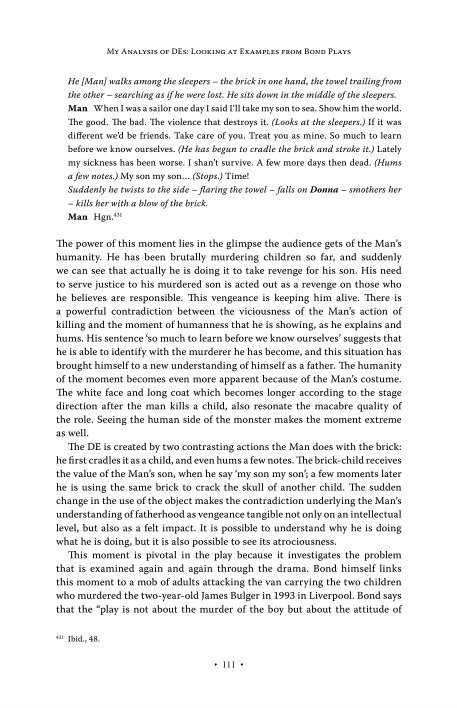

OCR
MY ANALYSIS OF DES: LOOKING AT EXAMPLES FROM BOND PLAYS He [Man] walks among the sleepers — the brick in one hand, the towel trailing from the other — searching as if he were lost. He sits down in the middle of the sleepers. Man When Iwas asailor one day I said I’ll take my son to sea. Show him the world. The good. The bad. The violence that destroys it. (Looks at the sleepers.) If it was different we’d be friends. Take care of you. Treat you as mine. So much to learn before we know ourselves. (He has begun to cradle the brick and stroke it.) Lately my sickness has been worse. I shan’t survive. A few more days then dead. (Hums a few notes.) My son my son... (Stops.) Time! Suddenly he twists to the side — flaring the towel - falls on Donna — smothers her — kills her with a blow of the brick. Man Hgn." The power of this moment lies in the glimpse the audience gets of the Mans humanity. He has been brutally murdering children so far, and suddenly we can see that actually he is doing it to take revenge for his son. His need to serve justice to his murdered son is acted out as a revenge on those who he believes are responsible. This vengeance is keeping him alive. There is a powerful contradiction between the viciousness of the Man’s action of killing and the moment of humanness that he is showing, as he explains and hums. His sentence ‘so much to learn before we know ourselves’ suggests that he is able to identify with the murderer he has become, and this situation has brought himself to a new understanding of himself as a father. The humanity of the moment becomes even more apparent because of the Man’s costume. The white face and long coat which becomes longer according to the stage direction after the man kills a child, also resonate the macabre quality of the role. Seeing the human side of the monster makes the moment extreme as well. The DE is created by two contrasting actions the Man does with the brick: he first cradles it as a child, and even hums a few notes. The brick-child receives the value of the Man’s son, when he say ‘my son my son’; a few moments later he is using the same brick to crack the skull of another child. The sudden change in the use of the object makes the contradiction underlying the Man’s understanding of fatherhood as vengeance tangible not only on an intellectual level, but also as a felt impact. It is possible to understand why he is doing what he is doing, but it is also possible to see its atrociousness. This moment is pivotal in the play because it investigates the problem that is examined again and again through the drama. Bond himself links this moment to a mob of adults attacking the van carrying the two children who murdered the two-year-old James Bulger in 1993 in Liverpool. Bond says that the “play is not about the murder of the boy but about the attitude of 431 Ibid., 48. + 111 +
Szerkezeti
Custom
Image Metadata
- Kép szélessége
- 1831 px
- Kép magassága
- 2835 px
- Képfelbontás
- 300 px/inch
- Kép eredeti mérete
- 1.16 MB
- Permalinkből jpg
- 022_000014/0111.jpg
- Permalinkből OCR
- 022_000014/0111.ocr
Bejelentkezés
Magyarhu
